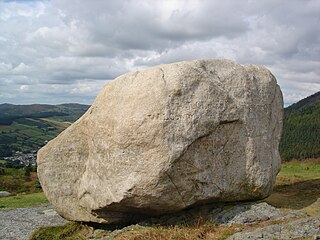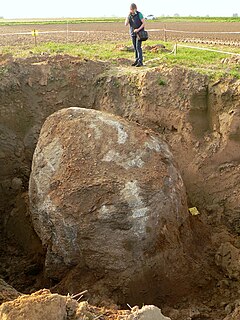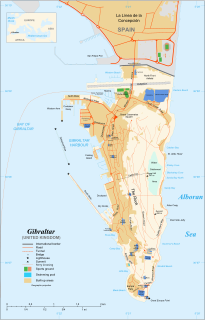 W
WBig Rock is a 16,500-tonne (18,200-ton) boulder that lies on the otherwise flat, relatively featureless, surface of the Canadian Prairies in Alberta. It is part of the 930-kilometre-long (580 mi) Foothills Erratics Train of typically angular boulders of distinctive quartzite and pebbly quartzite.
 W
WThe Blarney Stone is a block of Carboniferous limestone built into the battlements of Blarney Castle, Blarney, about 8 kilometres from Cork, Ireland. According to legend, kissing the stone endows the kisser with the gift of the gab. The stone was set into a tower of the castle in 1446. The castle is a popular tourist site in Ireland, attracting visitors from all over the world to kiss the stone and tour the castle and its gardens.
 W
WCloughmore or Cloghmore, known locally as "The Big Stone", is a huge granite boulder perched on a mountainside almost 1,000 feet (300 m) above the village of Rostrevor, County Down, Northern Ireland. It sits on the slopes of Slieve Martin in Kilbroney Park, overlooking Rostrevor Forest, Carlingford Lough and the Cooley Peninsula. It is popular destination for visitors, and is part of a National Nature Reserve and Area of Special Scientific Interest.
 W
WThe Colossus of Ostermunzel is a 27.5-tonne stone, a glacial erratic, found in a farmer's field east of Ostermunzel in Lower Saxony, Germany, in 2013. It was excavated and moved to a new location a kilometre away.
 W
WFrog Rock is glacial erratic on Bainbridge Island, Washington. The frog shape is made of two stacked granite boulders, painted by a pair of local residents to resemble a frog on June 6, 1971, The pair of boulders were reportedly once a single boulder which was dynamited in the 1950s or earlier, in order to remove it from a road right-of-way. After the dynamiting, the rock was known as "Split Rock".
 W
WFrog Rock is a landmark located on a privately owned roadside park off U.S. Route 44 in Eastford, Connecticut. The rock is a large glacial erratic painted green with a white lip and eyes to resemble a lugubrious frog. The rock was first painted and turned into an attraction in 1881 by state legislator Thomas J. Thurber, who passed the rock frequently on trips to Hartford and observed that it resembled the shape of a squatting frog. The location became a popular roadside picnic area for many years for travelers between Providence and Hartford. In 1997 a group of Thurber's descendants repainted it, vowed to maintain Frog Rock in perpetuity, and added a memorial to Thurber on a nearby rock.
 W
WHaleets is a sandstone glacial erratic boulder with inscribed petroglyphs on Bainbridge Island, Washington. The Native American Suquamish Tribe claims the rock, on a public beach at Agate Point on the shore of Agate Passage, as part of their heritage. The exact date the petroglyphs were carved is unknown but is estimated to be around 1000 BCE to 400 or 500 CE, the latest date being when labrets were no longer used by Coast Salish peoples.
 W
WThe Iyo Stone is located in the Portland Japanese Garden, a traditional Japanese garden within Portland, Oregon's Washington Park, in the United States. It is a tribute to the first president of the Japanese Garden Society of Oregon, Philip Englehart, who served from 1963 to 1964.
 W
WThe Lawrence Lake erratic is a glacial erratic boulder near Lake Lawrence in Thurston County, Washington. The boulder is about 15 feet (4.6 m) tall. Lake Lawrence itself was formed when the Vashon Glaciation created most of the topography seen in the Puget Sound region. The erratic is one of the southernmost in the Puget Sound region, near the limit of the Yelm lobe of the Vashon Glacier in the Rainier area.
 W
WOmak Rock, also known as Balance Rock, is a balancing rock in the Colville Indian Reservation, in the U.S. state of Washington. Located within the Greater Omak Area of the Okanogan Country, the glacial erratic is about 1,340 feet (410 m) from Omak Lake. It is positioned within the vicinity of the 1872 North Cascades earthquake, which it survived. The fact of its survival has been the basis of studies to help determine the acceleration and intensity of the quake. Some believe that the epicenter of the earthquake may have been very close to Omak Rock. The Confederated Tribes of the Colville Reservation believe that the rock represents a symbol of nature's perfection in the region.
 W
WPlymouth Rock is the traditional site of disembarkation of William Bradford and the Mayflower Pilgrims who founded Plymouth Colony in December 1620. The Pilgrims did not refer to Plymouth Rock in any of their writings; the first known written reference to the rock dates to 1715 when it was described in the town boundary records as "a great rock." The first documented claim that Plymouth Rock was the landing place of the Pilgrims was made by Elder Thomas Faunce in 1741, 121 years after the Pilgrims arrived in Plymouth.
 W
WThe Rock of Gibraltar, also known as the Jabel-al-Tariq, is a monolithic limestone promontory located in the territory of Gibraltar, near the southwestern tip of Europe on the Iberian Peninsula. It is 426 m (1,398 ft) high. Most of the Rock's upper area is covered by a nature reserve, which is home to around 300 Barbary macaques. These macaques, as well as a labyrinthine network of tunnels, attract many tourists each year.
 W
WRockall is an uninhabitable granite islet in the exclusive economic zone (EEZ) of the United Kingdom, situated in the North Atlantic Ocean. It is claimed by the United Kingdom as its territory. This claim is not recognised by its neighbours.
 W
WThe Skystone is an andesite glacial erratic boulder in Bonney Lake, Washington. The boulder was deposited approximately 13,000 years ago. The stone's height and width are 4.5 by 12 feet.
 W
WSocotra Rock is a submerged rock 4.6 metres (15 ft) below sea level located in the Yellow Sea. International maritime law stipulates that a submerged rock outside of a nation's territorial sea can not be claimed as territory by any nation. However, the rock is the subject of a maritime dispute between South Korea and China, which consider it to lie within their respective exclusive economic zones.
 W
WThe Solovetsky Stone is a monument in honor of victims of political repression in the Soviet Union and fighters for freedom. The monument stands in Troitskaya Square in Saint Petersburg, in the vicinity of several other buildings, directly related to political repressions in the USSR—the House of Tsarist Political Prisoners, the prison and the necropolis of the Peter and Paul Fortress, and the Bolshoy Dom. Nowadays it also serves as a central spot of all memorial events and gatherings related to actual human rights problems.
 W
WWedgwood Rock is a glacial erratic near the neighborhood of Wedgwood in Seattle, Washington. Its mineral composition matches that of Mount Erie, on Fidalgo Island in Skagit County, Washington, 55 mi (89 km) north. Prior to the establishment of the Wedgwood neighborhood, the erratic was known first as Lone Rock and later simply as Big Rock. Transported to its site by the Puget Lobe of the Cordilleran Ice Sheet during the Vashon Glaciation more than 14,000 years ago, it was a landmark for Native Americans in what was once a dense forest. Today, the rock sits in a residential neighborhood on 28th Avenue NE, near NE 72nd Street, still surrounded by trees and brush, and kept clear by local residents.
 W
WSims Corner Eskers and Kames National Natural Landmark of Douglas County, Washington and nearby McNeil Canyon Haystack Rocks and Boulder Park natural landmarks contain excellent examples of Pleistocene glacial landforms. Sims Corner Eskers and Kames National Natural Landmark includes classic examples of ice stagnation landforms such as glacial erratics, terminal moraines, eskers, and kames. It is located on the Waterville Plateau of the Columbia Plateau in north central Washington state in the United States.